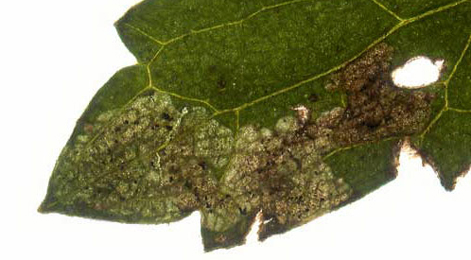|
||||||
|
Phytomyza
notata Meigen, 1830 Phytomyza
notata Meigen, 1830. Systematische Beschreibung der bekannten
europaischen zweiflugeligen Insekten. 6: 193 |
||||||||||||||||||||||||||||||||||||||||||||||||||||||||||||||||||||||||||||||||||||||||||||||||||||||||||||||||||||
Leaf-miner: Mine short, broad, essentially linear, sometimes with a small brown patch at beginning. Pupation external (Spencer, 1972b: 70 (fig. 228), 73); Spencer, 1976: 459 (fig. 806), 460). A short, broad corridor, with irregular sides. The mine often starts at a browned spot in the centre of the leaf. Pupation outside the mine (Bladmineerders van Europa).
Larva: The larvae of flies are leg-less maggots without a head capsule (see examples). They never have thoracic or abdominal legs. They do not have chewing mouthparts, although they do have a characteristic cephalo-pharyngeal skeleton (see examples), usually visible internally through the body wall. Puparium: The puparia of flies are formed within the hardened last larval skin or puparium and as a result sheaths enclosing head appendages, wings and legs are not visible externally (see examples). Dark brown; posterior spiracles each with an ellipse of some 20 minute bulbs (Spencer, 1976: 460). Hosts in Great Britain and Ireland:
Hosts elsewhere:
Time of year - mines: July-August, October-November. Time of year - adults: August. Distribution in Great Britain and Ireland: Probably widespread, at least in south. Surrey (Mickleham), Middlesex (Scratch Wood) (Spencer, 1972b: 73), Inner Hebrides (Isle of Coll) (Bland, 1992); Cambridgeshire, Dorset, Glamorgan, Monmouthshire, South-west Yorkshire and Surrey (NBN Atlas). Distribution elsewhere: Widespread in continental Europe including Denmark, Finland, Germany, Italy, the [former] U.S.S.R. (Kr, Svir) (Spencer, 1976: 460), Poland (Mines in BMNH), The Netherlands (Bladmineerders van Europa), Germany (Spencer, 1976: 574), Belarus, French mainland, Lithuania, Poland and Switzerland (Fauna Europaea). NBN Atlas links to known host species:
British and Irish Parasitoids in Britain and elsewhere:
|
|
|
|
| External links: | Search the internet: |
| Biodiversity Heritage Library Bladmineerders van Europa British leafminers Encyclopedia of Life Fauna Europaea NBN Atlas NHM UK Checklist |
Find
using Google Find using Google Scholar Find images using Google |
| Last updated 10-Jul-2019 Brian Pitkin | ||

